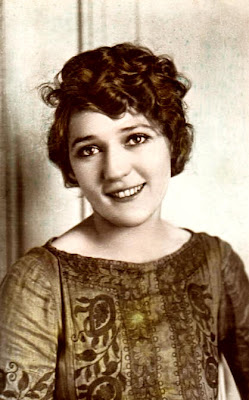 |
| Colleen Moore |
Colleen Moore is not remembered as well as the other flapper girls of the 1920s, including Clara Bow and Louise Brooks, but she was actually the first "definitive" flapper. After Olive Thomas gave birth to this cinematic presence in 1920, Colleen kicked things up a notch and solidified what such terminology meant with her performance in Flaming Youth. While Clara gave the flapper sex and Louise later brought mystery, Colleen brought the initial ingredients of fun, life, and liberty. The younger generations, particularly women, were embracing the rolling times of a new era, and Colleen was one of the pioneers to light the way.
Her charismatic onscreen presence and natural gift for acting were on prophesied in her adolescence. She knew she wanted to be a movie star, looking up to the first Miss Independent pioneer Mary Pickford as a guide. With her intelligence and burning ambition, it didn't take long for her to catch fire in Hollywood, after an initial boost from D.W. Griffith. Thus, the awkward, skinny girl with one blue eye and one brown became a major power player influencing the nation through her exciting and touching performances.
More than a flapper, Colleen could easily morph from her generation's power child to the comedienne, to the tragedienne, to the romantic. Lilac Time remains a poetic depiction of young love, the sentimental kind all long for in their memories. Her transition to sound film in works like The Power and the Glory and her final project The Scarlet Letter also show the drama queen at her most intense with her uncanny ability to convey both pain and courage. This intelligent, business-savvy lady would prosper through her 18 year career, save and invest her money, and build her dream house ("The Enchanted Caste" doll house which is now on display in Chicago's Museum of Science and Industry).
She was a bit unlucky at love, marrying four times-- two of which ended in divorce, the other half ending in her spouse's death and finally her own-- but many believe that former lover King Vidor was the one who got away, (or was it she who escaped him)? Whatever the case, this role model of freedom, spirit, and grace continues to flicker on, burning the candle at both ends into eternity and bringing well needed life back into the universe when one is lucky enough to glimpse one of her few remaining films. What she gave will never deteriorate, will never be lost. It lives on in the 'flaming youth' of every generation.



































